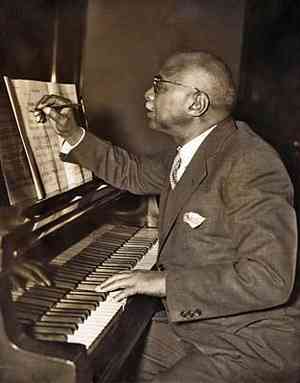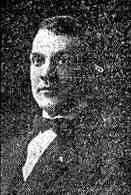


William Christopher Handy
Source: Historic Memphis
Launching the blues portion of the HMR Project is William Handy. As for red on this page, that was a joke (blues/red you know) until I discovered that Scott Alexander's online discography, Red Hot Jazz, had gone off line. A couple of dates in the account below are thanks to Alexander as noted in the VF History, but there is no way to reference them. You'll have to take my word for it and hope with crossed fingers that I got it right. So it's the Red Hot Blues now, in memory of a classically important website of no small assistance to the VF History. The vanishing of Red Hot Jazz has given a whole lot of folks the blues.
As Williams' autobiography of 1941 is titled 'Father of the Blues' it may be helpful to set the stage a little. Handy's blues are not those of the rural south intermeshed with early gospel, but those developed out of ragtime in the big city. "The blues" as a term is thought to have first been used in sheet music per 'I Have Got the Blues To Day' in 1850 w music by Gustov Blessner and lyrics by Sarah M. Graham. That was blues in sentimentality but not music. Come 'Oh Ain't I Got the Blues' by A.A. Chapman in 1971, again with account of a sad affair but not blues. There is in the blues an undertow of humor with its woeful complaints about every little ache one can have about every little thing. Humor entered the blues per 'Oh Susie! This Coon Has Got the Blues' by J.W. Murray & F.C. Mack. This also the earliest known association of blues with the black experience. In 1901 Chris Smith and Elmer Bowman wrote 'I've Got de Blues' with its title in so-called black jargon. Smith and Bowman were black vaudeville performers who later worked with Jimmy Durante.
'I've Got de Blues' Composition: Chris Smith & Elmer Bowman 1901
In 1908 Italian singer, Antonio Maggio, published 'I Got the Blues':
'I've Got the Blues' Composition: Antonio Maggio 1908
In 1909 Robert Hoffman published 'I'm Alabama Bound'. Though that was also promoted as 'The Alabama Blues' it was not blues:
'I'm Alabama Bound' aka 'The Alabama Blues' Composition: Robert Hoffman 1909
The first real blues is credited to Hart Wand per 'Dallas Blues' in 1912 with lyrics by Lloyd Garrett.

Hart Wand
Source: Wikipedia
Born in Topeka, Kansas, in 1887, Wand was an Oklahoma City violinist, band leader and businessman whose father had been a druggist before heading to Oklahoma City upon the Land Rush in 1889. Wand inherited the business upon his father's death in 1909, whence he took it to Chicago, then New Orleans, then expanded sales throughout the world. The demands of business left Hart's contributions to music minimal, 'Dallas Blues' his single claim to fame. Nor did Wand record 'Dallas Blues', leaving that to Marie Cahill who, after two destroyed matrices recorded on 1 November of 1916, succeeded on 2 Jan of 1917 toward the issue of Victor 55081 [DAHR]. 'Dallas Blues' is performed more recently by pianist, Sue Keller, below:
'Dallas Blues' Composition: Hart Wand & Lloyd Garrett 1912
Wand died in New Orleans on August 9, 1960, at 73 years of age. As commented, due to the demands of manufacturing drugs around the world he was a one-act pony when it came to musical renown. That he left to people in the music business like William C. Handy, a brass musician born in Florence, Alabama, in 1873. Handy's parents were very religious, his father a pastor. The story goes that as a youth Handy had saved money to buy a guitar. But upon doing so his father made him return it, then enrolled him in organ lessons, the guitar an instrument associated with the undesirable, the organ otherwise. But Handy didn't like playing organ, so he purchased a cornet. It isn't known what his parents thought of that instrument, but Handy kept his membership in a local band secret. He put together his own band, the Lauzetta Quartet, in 1892, which disbanded the same year. But the next year finds Handy playing cornet at the Chicago World's Fair. At age 23 (1896) Handy became leader of Mahara's Colored Minstrels, with which he toured from Chicago to points south, including Texas and Cuba. In 1900 Handy began teaching music at the Alabama Agricultural and Mechanical College for Negroes. But Handy preferred Southern folk music to classical, so in 1902 he put together a minstrel group and traveled throughout Mississippi to study the blues. Handy eventually took his band to Memphis in 1909 where they played the clubs on Beale Street, now long since famous as the major hub of Delta blues. It was 1912 when Handy published the sheet music for 'Memphis Blues', originally titled 'Mister Crump'. Its first commercial recording was by the Victor Military Band:
'Memphis Blues' by the Victor Military Band Recorded 15 July 1914
'Memphis Blues' by the Charles Prince Band Recorded 24 July 1914
'Memphis Blues' Voice by Morton Harvey Recorded 2 Oct 1914
'Memphis Blues' Piano Roll by Eubie Blake 1921
'Memphis Blues' Tutorial by William Handy at guitar on 9 May 1938
It was 1914 that Handy composed 'St. Louis Blues'. He later recorded it on 26 December, 1939, with the W. C. Handy Orchestra in which he played cornet:
'St. Louis Blues' W. C. Handy Orchestra Recorded in NYC 26 Dec 1939 Issued on Philharmonic FR-81-A
Ten years later Handy performed a more bemoaning version on trumpet on Ed Sullivan's 'Toast of the Town':
'St. Louis Blues' Trumpet: W. C. Handy 'Toast of the Town' on 18 Dec 1949
Also authored in 1914 was Handy's 'Yellow Dog Blues'. He considered he might make $100 with it, but it became his highest-selling issue:
'Yellow Dog Blues' Piano: Sue Keller Composed 1914
Handy came down with a case of 'The Hesitating Blues' in 1915:
'Hesitating Blues' Piano: Dorian Henry Composed 1915
More popular was 'Beale Street Blues' authored in 1917:
'Beale Street Blues' Prince's Band Recorded 24 May 1917 Issued on Columbia A2327
It was 1917 when Handy himself began to record. His first session to issue was held in New York City on 21 September toward 'Fuzzy Wuzzy Rag' on Columbia A2421/2910 w 'The Snaky Blues' flip side to A2421:
'Fuzzy Wuzzy Rag' Handy's Memphis Blues Band Recorded 21 Sep 1917 Issued on Columbia A2421 A
'Snakey Blues' Handy's Memphis Blues Band Recorded 21 Sep 1917 Issued on Columbia A2421 B
Three days after recording 'Fuzzy Wuzzy' Handy put away 'Bunch o Blues' for issue on Columbia A2418/2911. Columbia Records wasn't the behemoth at that time that it become to this day. Founded in 1987 to issue cylinders, Columbia began selling discs in 1901. Its main competitors were Edison Records founded in 1888 and the Victor Talking Machine Company founded in 1901. RCA (Radio Corporation of America), defunct since 1986, acquired Victor in 1929. Paramount was another large label for which Handy recorded, founded in 1917, though to go defunct in the Great Depression year of 1932.
In 1922 Handy and his his Memphis Blues Band put away such as 'Early Every Morn' w "Loveless Love' on Paramount 12011. Those featured his daughter, Katherine, at vocals:
'Early Every Morn' Katherine Handy w the Memphis Blues Band Issued 1922 on Paramount 12011
'Loveless Love' Katherine Handy w the Memphis Blues Band Issued 1922 on Paramount 12011
The W.C. Handy Orchestra recorded such as 'Aunt Hager's Blues' w 'Louisville Blues' toward Okeh 8046 in early 1923:
'Aunt Hagar's Blues' W.C. Handy Orchestra Okeh 8046 A 1923
'Louisville Blues' W.C. Handy Orchestra Okeh 8046 B 1923
Okeh had been founded in 1918 toward its purchase eight years later by Columbia in 1926, the same year that Handy began writing five books concerning the blues. It was Handy's Sacred Singers which released 'Aframerican Hymn' bw 'Let’s Cheer the Weary Traveler' on Paramount 12719 in 1929. In his later years Handy moved to Harlem where he was blinded by a fall from a subway platform in 1943. So many Southern blues artists were either born blind or blinded along the way that one could think such requisite to being a blues musician. By way of explanation, there were few ways for a blind person to survive in those years, nor a lot now, thus busking on the streets for change. As for Handy, he died on March 28, 1958, of bronchial pneumonia. Acquiring major popularity along the way, his funeral was attended by some 25,000, another 150,000 in the streets [obit].
Sources & References: Early Blues:
Abbott & Seroff Ragged But Right (University Press of Mississippi 2007)
David A. Jasen Beale Street and Other Classic Blues (Dover 1998)
Michael Saffle Perspectives on American Music, 1900-1950 (Routledge 2000)
Robert Hoffman:
Antonio Maggio:
Scores:
I Have Got the Blues To Day!:
Titles:
Dallas Blues (Hart Wand 1912):
I Got the Blues (Antonio Maggio 1908):
Peter C. Muir Popular Blues In America, 1850-1920 (U of Illinois Press 2010)
I Have Got the Blues To Day! (Blessner & Graham 1850):
I'm Alabama Bound (Robert Hoffman 1909)
I've Got de Blues (Smith & Bowman 1901):
Further Reading:
Sources & References: William C. Handy:
Compositions:
Beale Street Blues (1917)
St. Louis Blues (1914)
Yellow Dog Blues (1914)
Discographies:
Sessionographies:
Handy in Soundtracks:
IMDb
Further Reading:
Sue Keller (pianist)
Classical Main Menu Modern Recording
hmrproject (at) aol (dot) com